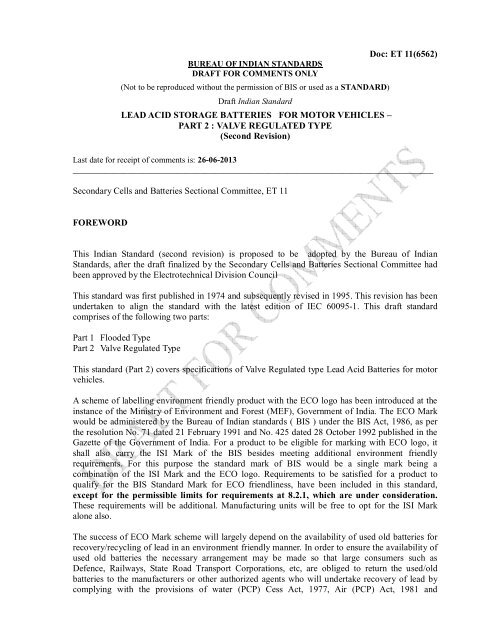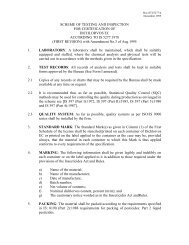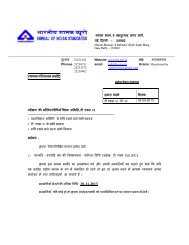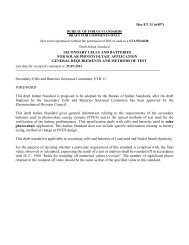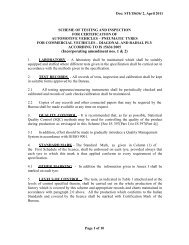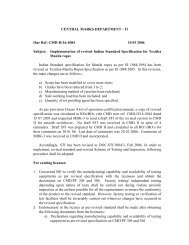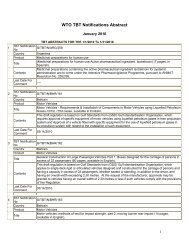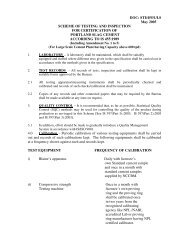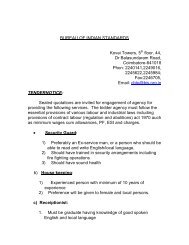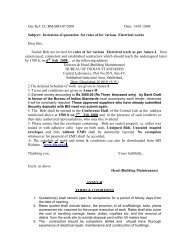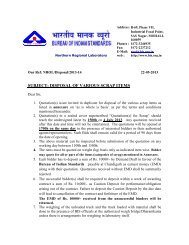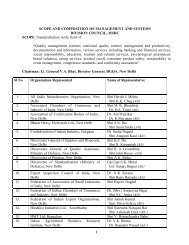Doc: ET 11(6562) LEAD ACID STORAGE BATTERIES FOR ... - BIS
Doc: ET 11(6562) LEAD ACID STORAGE BATTERIES FOR ... - BIS
Doc: ET 11(6562) LEAD ACID STORAGE BATTERIES FOR ... - BIS
- No tags were found...
Create successful ePaper yourself
Turn your PDF publications into a flip-book with our unique Google optimized e-Paper software.
3.1.1 Manufacturers name3.1.2 Class of battery: A, B or C (See 1.1.1)3.1.3 Nominal voltage : 12VNominal Cranking current: I cc (A) (see 4.1.1)3.1.4 Capacity : ( see 4.1.2 )- either 20 hour capacity C n (Ah)- Or reserve capacity C r, n (min)3.1.5 Safety labellingBatteries shall be marked with the six colored symbols as described in Annex B.3.1.6 Country, Month & year of manufacture3.1.7 <strong>BIS</strong> Certification MarkingThe batteries may also be marked with the standard Mark.The use of the standard mark is governed by the provisions of bureau of Indian standards Act,1986 and the rules and regulations made thereunder. The details of conditions under which thelicence for the use of standard mark may be granted to manufacturers or producers may be obtainedfrom the bureau of Indian standards.3.1.8 ECO MarkFor a product to be eligible for marking with ECO logo, it shall also carry the ISI Mark of the <strong>BIS</strong>besides meeting additional environment friendly requirements. For this purpose the Standard Markof <strong>BIS</strong> would be a single mark being a combination of the ISI Mark and the ECO logo.Requirements to be satisfied for a product to qualify for the <strong>BIS</strong> Standard Mark for ECOfriendliness, given in 8.4 Functional characteristics4.1 Electrical characteristics4.1.1 The cranking performance is the discharge current I CC , as indicated by the manufacturer,which a battery can supply according to 6.3.4.1.2 The capacity of a starter battery is defined for a temperature of 25°C ± 2°C.It may be indicated by the manufacturer as either:- nominal 20 hour capacity C n or- Nominal reserve capacity C r, nThe 20 hour nominal capacity C n is the electric charge in ampere hours (Ah) that a battery cansupply with a current:3
C nI n = (A)20Until the terminal voltage falls to U f = 10.50 V.The effective 20 hour capacity C e shall be determined by discharging a battery with constantcurrent I n to U f = 10.50 V (see 6.1). The resultant discharge time, in hours, is used for theverification of C nThe nominal reserve capacity C r, n is the period of time (in minutes) for which a battery canmaintain a discharge current of 25A to a cut-off voltage U f = 10.50 V.The effective reserve capacity C r, e shall be determined by discharging a battery with the constantcurrent I = 25A to U f = 10.50 V (see 6.2). The resultant discharge time, in minutes, is used for theverification of C r, n .NOTE For the correlation (relationship) of C n and C r, n see Annex A.4.1.3 The charge acceptance is expressed as the current I ca which a partially discharged batteryaccepts at 0°C and a constant voltage of 14.40 V4.1.4 The charge retention is defined as the cold cranking performance of the charged and filledbattery after storage on open circuit under defined conditions of temperature and time (see 6.5).4.1.5 Endurance test consists of two parts:4.1.5.1 corrosion test represents the ability of a battery to perform repeated overcharge/storageperiods (see 6.6).4.1.5.2 Cycling test represents the ability of a battery to perform repeated discharge/ rechargecycles and long rest periods on open circuit. This ability shall be tested by a series of cycles andrest periods under specified conditions after which the cold cranking or the capacity performancesshall be determined (see 6.6)4.2 Mechanical characteristics4.2.1 Vibration resistance represents the ability of a battery to maintain service under periodic orirregular acceleration forces. Minimum requirements shall be verified by a test (see 6.7).4.2.2 Electrolyte retention is the ability of a battery to retain the electrolyte under specified physicalconditions (see 6.8)5 General test conditions5.1 Sampling of batteriesAll tests shall be carried out on new battery samples. Samples shall be considered as “new” notlater than 30 days after shipment date of manufacturer4
5.2 Preparation of batteries prior to test - Definition of a fully charged batteryAll tests shall commence with fully charged batteriesBatteries shall be considered as fully charged if they have undergone one of the two chargingprocedures of 5.2.1 and 5.2.2 carried out at 25°C ± 10°C. If necessary, an appropriate temperaturecontrol system, for example a water bath, shall be used.5.2.1 Charging of valve regulated batteries at constant current (two step method)The battery shall be charged:- at a constant current of 2 I n (see 4.1.2) until the voltage reaches 14.40V;- Then at a constant current of I n for 4h.5.2.2 Charging of valve regulated batteries at constant voltage and constant current(two step method)The battery shall be charged:- at a constant voltage of 14.40 V ± 0.10V for 20h with the maximum current limited to 5 I n(see 4.1.2),- Then with a constant current of 0.5 I n for 4hNOTE If neither complete knowledge of the battery construction nor a specification from the manufacturer isavailable, then charging according to the present sub clause (5.2.2), is recommended.5.3 Measuring Instruments5.3.1 Electrical measuring instrumentsThe range of instruments used shall be appropriate for the magnitude of the voltage or current to bemeasured.- Voltage measurement:The instruments used for measuring voltages shall be digital voltmeters having an accuracyof ±0.04V or better.- Current measurement:The instruments used for current measurement shall be digital ammeters having anaccuracy of 1.0% or better. The assembly of ammeter, shunt and leads shall have anoverall accuracy of 1.0% or better.5.3.2 Temperature measurementThe thermometers used for measuring temperature shall have an appropriate range, and the value ofeach scale division shall not be greater than 1K. The accuracy of the calibration of the instrumentsshall be not less than 0.5K.5.3.3 Time measurementThe instruments used for measuring time shall be graduated in hours, minutes or seconds. Theyshall have an accuracy within ±0.1 % in all cases with the exception of cranking performance tests5
where the times measured in seconds shall have an accuracy within ±1.0%.5.4 Test sequence5.4.1 Batteries filled and chargedThe tests according to table 1 shall be carried out only if batteries have complied with the previoustests, and not later than one week after completion of the first part.20 h capacityTestTable 1 - Test/BatteryBattery1 2 3 4 5 6X X Xreserve capacityX X Xcranking performance X X X X X XCorrosion test XEndurance Tests(6.6)Cycling testXCharge retentionX(6.5)Charge acceptanceX(6.4)Electrolyte retentionX(6.8)Vibration resistanceX(6.7)6 Tests methods6.1 20 hour capacity check C e6.1.1 Throughout the duration of the tests, the battery shall be placed in a water bath at atemperature of 25°C ± 2°C. The terminal base of the battery shall be at least 15 mm but no morethan 25 mm above the level of the water. If several batteries are in the same water bath then thedistance between them and also the distance to the walls of the bath shall be at least 25 mm.6.1.2 The battery shall be discharged with the current I n (calculated according to 4.1.2) keptconstant at ±2% of the nominal value until the terminal voltage falls to 10.50V ± 0.05V. Theduration t(h) of the discharge shall be recorded. The beginning of the discharge shall take placebetween 1 h to 5 h after the completion of charging according to 5.2.The battery terminal temperature, measured shall be 25°C ± 2°C before the discharge begins.6.1.3 The capacity C e is as follows:C e= t x I n (Ah)If the final battery temperature is different from 25°C ± 2°C the following temperature correctionformula shall be used:6
C e 25°C = C eT [ 1 - 0.01(T - 25)]6.1.4 Requirement: See clause No.76.2 Reserve capacity check C r, e6.2.1 Throughout the duration of the tests, the battery shall be placed in a water bath at atemperature of 25°C ± 2°C. The terminal base of the battery shall be at least 15 mm but no morethan 25 mm above the level of the water. If several batteries are in the same water bath then thedistance between them and also the distance to the walls of the bath shall be at least 25 mm.6.2.2 The battery shall be discharged with a current 25 A ± 1% until the terminal voltage falls to10.50 V ± 0.05V. The duration t (in minutes) of the discharge shall be recorded. The beginning ofthe discharge shall take place between 1 h to 5 h after the completion of charging according to 5.2NOTE - The battery terminal temperature, measured shall be 25°C ± 2°C before the discharge begins.C r, e= t (min)If the final battery temperature is different from 25°C ± 2°C the following temperature correctionformula shall be used:C r, e 25°C = C r, e T [ 1 - 0.009 (T - 25)]6.2.3 Requirement: (see 7)6.3 Cranking performance test6.3.1 Cranking performance test - standard temperature6.3.1.1 After a rest period of up to 24h, the battery shall be placed in a cooling chamber with(forced) air circulation at a temperature of -18°C ± 1°C until the battery terminal temperature hasreached -18°C ± 1°CNOTE It is generally accepted that the required temperature will be achieved after a minimum period of24h in the cooling chamber.6.3.1.2 The battery shall then be discharged, either within or outside the cooling chamber, within 2min after the end of the cooling period with a current I cc (see 4.1.1). This current shall be keptconstant to within ± 0.5 percent during the discharge.6.3.1.3 After 10 s discharge, the terminal voltage U f10s shall be recorded. After 30 s discharge, theterminal voltage U f30s shall also be recorded and the current shall be cut off.NOTE - 6.3.1.1 to 6.3.1.3 comprise stage 1 of the cranking performance test.6.3.1.4 The test shall be continued after a rest time of 20 s ± 1s.6.3.1.5 the battery shall then be discharged at 0.6 I cc . The current shall be kept constant to within ±0.5% during the discharge. The discharge shall be terminated when the battery voltage reaches 6V.6.3.1.6 The discharge time (t 6v ), in seconds, at 0.6 I cc to 6V shall be recorded.7
NOTE - 6.3.1.4 to 6.3.1.6 comprise stage 2 of the cranking performance test.6.3.2 Cranking performance test -- Very cold climatesThis test shall be performed only if the battery is specified for very cold climate application by themanufacturer.The test method is the same as defined above for the standard temperatures with- cooling chamber temperature = -29°C ± 1°C;- I cc for very cold climate rated on the battery label by the manufacturer6.3.3 Requirement: (see.7)6.4 Charge acceptance test6.4.1 The test shall be carried out on batteries which have been charged in accordance with 5.2.26.4.2 The battery shall be placed in a water bath at a temperature of 25°C ±2°C. The terminal baseof the battery shall be at least 15 mm but no more than 25 mm above the level of the water. Ifseveral batteries are in the same water bath then the discharge between them and also the distanceto the walls of the bath shall be at least 25 mm.6.4.3 The battery shall be discharged at a current I o :I o = Ce 20 / 10 h (A) for 5 hThe value C e shall be taken according to clause 6.1,6.4.4 Immediately after the discharge, the battery shall be cooled at a temperature of 0°C ± 1°C fora minimum of 20h or until the battery terminal temperature has reached 0°C ± 1°C6.4.5 At this temperature of 0°C ± 1°C, the battery shall be charged at a constant voltage of 14.40V ± 0.10 V.After 10 min, the charging current I ca shall be recorded..6.4.6 Requirement: See clause No. 76.5 Charge retention test6.5.1 A fully charged battery (according to 5.2), with its vent plugs firmly in place and a clean drysurface, shall be stored at 40°C ±2°C on open circuit for a period of 49 days. No connecting clampsor cables shall be attached to the terminals.6.5.2 After this storage period, the battery shall be submitted, without recharge, to a crankingperformance test at -18°C and a current I = 0.6I cc. The voltage after 30 s ( U 30s ) shall be recorded.6.5.3 Requirement: See Clause No.76.6 Endurance test for batteries8
6.6.1 Corrosion test6.6.1.1.The test shall be carried out on fully charged batteries in accordance with 5.2.2 but with thetimes of the constant voltage charge being limited to 10 h.6.6.1.2 The battery shall be placed in a water bath maintained at a temperature of 60°C ± 2°C. Theterminal base of the battery shall be atleast 15 mm but not more than 25 mm above the level of thewater. If several batteries are in the same water bath then the distance between them and also thedistance to the walls of the bath shall be atleast 25 mm.6.6.1.3 The battery, maintained at 60°C ± 2°C, shall be charged at a constant voltage of 14.00 V ±0.10V for a period of 13 days.6.6.1.4 The battery shall be stored on open circuit, still at 60°C ± 2°C, for a period of 13 days. Noconnecting clamps or cables shall be attached to the terminals.6.6.1.5 The battery shall be cooled to reach 25°C ± 2°C.6.6.1.6 The battery shall then be recharged in accordance with clause 5.2.2 but with the times of theconstant voltage charge being limited to 6 h.6.6.1.7 the battery, maintained at 25°C ± 2°C, shall be stored for a rest period of 20h.6.6.1.8 The battery shall be discharged with a current of 0.6 I cc at 25°C ± 2°C for 30s. The 30svoltage shall be recorded.6.6.1.9 The sequence 6.6.1.1 to 6.6.1.8 constitutes one corrosion test unit.6.6.1.10 The whole sequence 6.6.1.1 to 6.6.1.8 shall be repeated and the test shall be terminatedwhen the battery voltage reaches less than 7.2V at 30s with a current of 0.6I cc in cranking test at25°C ± 2°C (see 6.6.1.8)6.6.1.<strong>11</strong> Requirements: number of units, see clause 7.6.6.2 Cycling test 16.6.2.1 Test shall be carried out on fully charged batteries in accordance with 5.2.6.6.2.2 Throughout the whole test period, with the exception of the rapid discharge test at thetemperature of -18°C ± 1°C, the battery shall be placed in a water bath at a temperature of 25°C ±2°C. The terminal base of the battery shall be at least 15 mm but not more than 25 mm above thelevel of the water. If several batteries are in the same water bath then the distance between themand also the distance to the walls of the bath shall be at least 25 mm.6.6.2.3 The batteries shall be connected to a device where they undergo a series of discharge/chargecycles for a required number of cycles, each cycle comprising:a) a discharge for 1 hour at a current, in amperes, of I = 5 I n ,b) Immediately followed- by a recharge for 2h and 55 min at a voltage of 14.40V ± 0.10V or 14.80V ± 0.10V(according to the manufacturer recommendation) with a maximum current in amperesbeing limited to I max = 10 I n ( see 4.1.2 ), and9
- for 5 min at a constant current, in amperes, of I = 0.5 I n6.6.2.4 the test shall be terminated if the battery voltage drops below 10.50 V during the dischargeprior to completion of the required number of cycles (see Clause 7 )6.6.2.5 When the cycling is over, the battery shall be placed in a cooling chamber with (forced) aircirculation at a temperature of -18°C ± 1°C for a minimum of 20 h or until the battery terminaltemperature has reached -18°C ± 1°C6.6.2.6 The battery shall then be discharged after the end of the cooling period with a current 0.6I cc6.6.2.7 After 30 s of discharge, the voltage across the battery terminals shall be measured. It shallnot be less than 7.20 V. The discharge shall then be terminated.6.6.2.8 Requirements : number of cycles, see clause 76.6.3 Cycling test 26.6.3.1 The test shall be carried out on batteries that have been charged in accordance with 5.2.26.6.3.2 Throughout the whole test period, with the exception of the rapid discharge test at thetemperature of -18°C ± 1°C, the battery shall be placed in a water bath at a temperature of 25°C ±2°C. The terminal base of the battery shall be at least 15 mm but not more than 25 mm above thelevel of the water. If several batteries are in the same water bath then the distance between themand also the distance to the walls of the bath shall be atleast 25 mm.6.6.3.3 The batteries shall be connected to a device where they undergo a series of 18 cycles, eachcycle comprising:a) a discharge for 2 hour at a current, in amperes, of I = 5 I n ,b) Immediately followed- by a recharge for 4 h and 45 min at a voltage of 14.40V ± 0.10V or 14.80V ± 0.10V(according to the manufacturer recommendation) with a maximum current in amperesbeing limited to I max = 5 I n ( see 4.1.2 ), and- for 15 min at a constant current in amperes of I = 0.5 I n6.6.3.4 The battery, maintained at 25°C ± 2°C shall be charged in accordance with 5.2.2 but withthe times at constant voltage charge being limited to 6 h6.6.3.5 The battery shall then be stored on open circuit, still at 25°C ± 2°C for 5h.6.6.3.6 The battery shall then be discharged at I = 5 I n down to 10.00 V ± 0.05 V (capacity:C)6.6.3.7 The battery shall then be recharged in accordance with 5.2.26.6.3.8 The sequence 6.6.3.2 to 6.6.3.7 constitutes one cycling test unit.6.6.3.9 The whole sequence 6.6.3.2 to 6.6.3.7 shall be repeated to the required number of units. Theactual capacity at the end of the last unit shall be C ≥ 0.5 C n6.6.3.10 If the criteria C ≥ 0.5 C n is achieved, the battery shall be placed in a cooling chamber10
with(forced) air circulation at a temperature of - 18°C ± 1°C for a minimum of 20 h or until thebattery terminal temperature has reached - 18°C ± 1°C6.6.3.<strong>11</strong> The battery shall then be discharged after the end of the cooling period with a current of0.6I cc6.6.3.12 After 30 s of discharge, the voltage across the battery terminals shall be measured. It shallnot be less than 7.20 V. The discharge shall then be terminated.6.6.3.13 Requirements : number of units, see clause 7.6.6.4 Cycling test 3 (applicable to batteries with C r from 40 min to 150 min)6.6.4.1 The test shall be carried out on batteries that have been charged in accordance with 5.2.26.6.4.2 Throughout the whole test period, the battery shall be placed in a water bath at atemperature of 40°C ± 2°C (or 75°C ± 3°C).The terminal base of the battery shall be at least 15 mmbut not more than 25 mm above the level of the water. If several batteries are in the same waterbath then the distance between them and also the distance to the walls of the bath shall be at least25 mm.6.6.4.3 The batteries shall be connected to a device where they undergo a continuous series ofcycles, each cycle comprising:-a) a discharge for 240s ± 1s at 25A ±0.1 Ab) Followed, within 10s, by a charge for 600s ± 1 s at the maximum charge current of 25 A ±0.1 A with a maximum charge voltage of 14.80 V ± 0.03V, with the interval between thecharge and the discharge periods not exceeding 10 s, for 100 h +12 -0 h.6.6.4.4 The battery, maintained at the temperature chosen in clause 6.6.4.2, shall be stored on opencircuit for between 65 h - 70h6.6.4.5 With the battery at the temperature selected in 6.6.4.2, discharge at I cc cranking amps for30 s. The terminal voltage at 30 s ( U 30s ) shall be recorded together with the number of cylcesdescribed in 6.6.4.36.6.4.6 The battery should be replaced on the cycling test without a separate charge, starting on the“charge” portion ’b)’ of the cycle.6.6.4.7 The cycling test should be considered complete when the terminal voltage at 30 s ( U 30s )of 6.6.4.5 falls to below 7.20 V. The number of cycles shall be determined by plotting the 30s (U 30s ) voltage values versus the cycle values. The point where the line crossing 7.20V shall be thecycle reported for that battery.6.6.4.8 Requirements : number of cycles, see clause 76.6.5 Endurance test sequenceAccording to their classification, batteries are submitted to the test sequence defined in Table 2.Table 2 - Endurance test sequence<strong>11</strong>
Battery classABTestCorrosionCycling 1 or 3 (40°C)Cycling 26.7 Vibration resistance testXXXX6.7.1 After charging according to 5.2, the battery shall be stored for 24 h at a temperature of 25°C ±2°C6.7.2 The battery shall be fastened rigidity to the table of the vibration tester. The fastening shall beof the same type as that used on a vehicle and secured by either- the bottom hold - downs or ledges on the lower part of the container and suitable hold -down clamps and bolts with M8 thread, tightened to a torque of between 15 Nm and 25 Nm,or- An angle - iron frame covering the upper edges of the battery case/cover assembly for aminimum width of X mm (see table 3), connected to the vibration table by four screwedrods with M8 thread, tightened to a torque of between 8 Nm and 12 Nm.6.7.3 The battery shall be subjected for a period of T(h) (see table 3) to a vertical vibration of afrequency of 30 Hz ± 2 Hz, these vibrations being as nearly sinusoidal as possible.The maximum acceleration on the battery shall reach the value Z(see table 3)NOTE - The battery temperature throughout the vibration shall be between 20°C and 30°C6.7.4 After a maximum of 4 h after the end of the vibration, the battery shall be subjected, withoutrecharge, to a discharge at a temperature of 25°C ± 2°C with a current I = I cc.The terminal voltage after 30s (U 30s ) discharge shall be recorded. The discharge shall then beterminated.Table 3- Values for vibration resistance testBattery classA, C BX 15 mm 33 mmT 2 h 8 hZ 30 ms -2 ± 1 ms -2 50 ms -2 ± 1 ms -26.7.5 Requirement: See clause No. 76.8 Electrolyte retention test6.8.1 After charging according to 5.2, the battery shall be stored for 4 h on open circuit at atemperature of 25°C ± 2°C.6.8.2 The battery shall then be tilted in each of the four directions at intervals of not less than 30 sbetween each tilting as follows:a) the battery shall be tilted through 45° from the vertical in a maximum period of 1 s ;12
) The battery shall be maintained in this position for 3s;c) The battery shall be returned to the vertical position in a maximum period of 1s.6.8.3 Throughout the tests described in clause 6.8.2, the battery must be examined for any sign ofelectrolyte leaking from the battery. The observations shall be recorded.6.8.5 Requirement: See clause No 77 RequirementsThe requirements applicable to essential functional characteristics are summarized in Table 4 belowTable 4 - Summary of RequirementsFunctional Characteristics Requirements Comments20 h capacity ( 6.1 ) C e ≥C nFor batteries rated inAhReserve capacity ( 6.2 ) C r e ≥C r nFor batteries rated inReserve capacityCranking performance test ( 6.3 )- 18°C or - 29°C (If specified)U 10s ≥ 7.5 VU 30s ≥7.2 Vt 6 v ≥40 sTotal time ≥ 90s =(30/0.6 s + 40 s)CompulsoryCompulsoryOptionalCharge acceptance ( 6.4 ) I ca ≥2I oCharge retention ( 6.5 ) U 30s ≥ 8.0 VEndurance ( 6.6 )Corrosion test (6.6.1)Number of units = 4Cycling test 1 (6.6.2)Cycling test 2 (6.6.3)Number of cycles = 120Cycling test 3(40°C &Number of units = 575°C) (6.6.4)Number of cycles = 34*Cr,n - 581 aVibration (6.7) U 30s ≥7.2 VElectrolyte retention (6.8)No evidence of liquid on the vent plugs.Or higher if specifiedOr higher if specifiedOr higher if specifiedFor both C e or C r e and the cranking performance, the specified values shall be met in at least one of the threerelevant discharges above (see 6.1, 6.2, and 6.3)a) This formula applies for C r from 40 min to 150 min8 ADDITIONAL REQUIREMENTS <strong>FOR</strong> ECO MARK8.1.1 The automotive lead acid batteries shall meet the relevant standards of Bureau of IndianStandards8.1.2 The product manufacturer must produce the consent/ clearance as per the provisions of water(PCP) Act. 1974, Water(PCP) Cess Act, 1977 and Air (PCP) Act, 1981 along with the authorisationif required under environment (protection )act, 1986 and rules made thereunder.8.1.3 The product packing may display in brief the criteria based on which the product has beenlabelled environment friendly.8.1.4 The product may be sold along with instructions for proper use so as to maximize the product13
performance and safe disposal8.1.5 The material used for product packing shall be recyclable or biodegradable.8.1.6 The manufacturer shall organize the collections/payback system for the used batteries andprovide documentary evidence by way of certificate or declaration to this effect to bureau of IndianStandards while applying for ECO Mark.8.2 Product specific Requirements8.2.1 The quantity of lead used, in Kg per battery (A) charged battery weight with electrolyte in Kg(B) and ratio A:B shall not exceed the limits given below:Table under Consideration.8.2.2 Lead used in batteries shall be recovered/manufactured through a process complying underthe provisions of water ( PCP ) Act, 1974, water ( PCP ) Cess Act, 1977 and Air ( PCP ) Act, 1981along with the authorization if required under Environment ( Protection ) Act, 1986 and rules madethereunder.NOTE — The manufacturer of the battery shall obtain documentary evidence from the lead manufacturer tothis effect such as consent/clearance from pollution control board and provide the same to <strong>BIS</strong> whichapplying for ECO Mark.8.2.3 The manufacturer of ‘Oxide’ as well as ‘Grid’ plates of the battery shall ensure fullcompliance of the provision under water (PCP) Act, 1974, Water (PCP) Cess Act, 1977 and Air(PCP) Act, 1981 along with the authorisation if required under Environment ( Protection ) Act,1986 and rules made thereunder.NOTE — Manufacturer of the battery shall obtain documentary evidence from the ‘Oxide’ and ‘Grid’ manufacturers to this effect suchas consent/Clearance from pollution control board and provide the same to <strong>BIS</strong> while applying for ECO Mark.8.2.4 The product shall contain the following percentage of recycled lead ( from post-consumerlead ) measured over a period of 3 months ( as a rolling average ) where 100 percent is the totalamount of lead contained in the batteries manufactured during the quarter:a) Up to 1 Year 25 percent, Minimumb) Up to 2 Years 40 percent, Minimumc) Up to 3 Years 50 percent, MinimumNOTE — The manufacturer shall provide documentary evidence by way of certificate or declaration to this effect to bureau of IndianStandards while applying for ECO Mark.Annex A(normative)Correlation between C n and C r, nThe value of C r, n (in minutes) may be estimated from C n (in ampere hours) using the followingequation:14
C r, n = β (C n ) αWhereα = 1.1201β = 1.1339Reciprocal equation:C n= δ (C r, n ) γWhereγ = 0.8928δ = 0.8939B Definition of the six colored symbolsAnnex B(normative)Safety labellingThe symbols mentioned in 3.1.5 are shown in Figure B.1:15
Figure B.1 - Symbols for safety labellingThe symbols shall have common dimensions as shown in Figure B.2 with a minimum dimension of10 mm.Figure B.2 - Dimensions for symbols in safety labellingThe symbols shall be located in a group on the top of the battery (as shown for example in figureB.1).No text in any language shall be included with the 6 symbol block.The meaning of the 6 symbols is given by ISO standardsThe meaning of the symbols are as follows:(RED)(BLUE)(RED)(YELLOW)(BLUE)(YELLOW)No smoking, no naked flames, no sparksShield eyesKeep away from childrenBattery acidNote operating instructionsExplosive gas----------16


